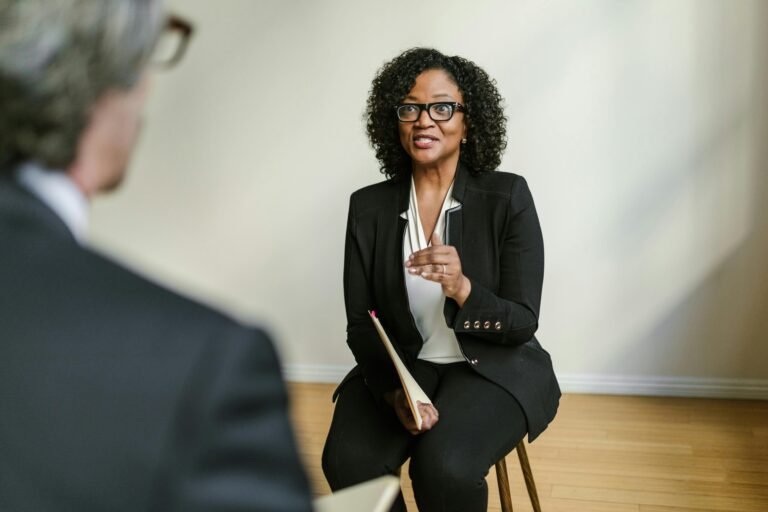The STAR method (Situation, Task, Action, and Result) is a powerful framework for answering behavioral interview questions, particularly for roles like tutoring, where demonstrating your ability to guide, engage, and help students overcome academic challenges is essential. By structuring your responses with STAR, you can clearly show how your skills and experience make you a great fit for the tutoring position.
If you’re preparing for a tutor job interview, whether for K-12, college-level, or test prep tutoring, the STAR method can help you provide clear, concise, and compelling responses that highlight your strengths.
Here are 10 original examples of how you might use the STAR method to answer common interview questions for a tutor job. These examples not only help you think through your experiences but also allow you to showcase the unique skills and strategies you bring to the table.
Interview Questions with Sample STAR Responses
Tell me about a time when you helped a student who was struggling with a difficult concept.
Sample Response:
- Situation: I was tutoring a high school student in algebra who was struggling with understanding quadratic equations.
- Task: My task was to help the student grasp the concept of factoring quadratics and applying it to problem-solving.
- Action: I started by breaking the problem down into simpler steps, using visual aids and interactive methods, such as drawing out the equations and providing real-life examples. I also asked the student to explain back to me in their own words to check their understanding and gave them lots of practice problems to reinforce the concept.
- Result: The student’s understanding of quadratic equations improved significantly. By the end of our tutoring sessions, they were able to confidently solve quadratic problems on their own and showed marked improvement in their class tests. This experience showcased my ability to simplify complex concepts and adapt my approach to fit the student’s learning style.
Tell me about a time when you had to adjust your teaching style for a student with a unique learning need.
Sample Response:
- Situation: I was tutoring a middle school student with ADHD who often found it hard to stay focused during long sessions.
- Task: My task was to tailor my teaching strategies to keep the student engaged while helping them improve their reading comprehension skills.
- Action: I broke down lessons into smaller, manageable chunks and incorporated frequent breaks. I used hands-on activities, like reading aloud together and discussing the text, to keep the student engaged. I also implemented visual aids and used positive reinforcement to reward their progress.
- Result: The student became much more focused during sessions and was able to finish reading assignments more efficiently. Their comprehension scores improved, and they expressed excitement about reading. This situation highlighted my flexibility and creativity in adapting teaching methods to meet individual needs.
Tell me about a time when you had to motivate a student who was losing interest in the subject.
Sample Response:
- Situation: I was tutoring a high school student who had lost interest in writing and had become disengaged with assignments in their English class.
- Task: My task was to reignite the student’s interest in writing and help them improve their skills.
- Action: I started by learning about the student’s interests and suggested they write about topics they were passionate about. I also introduced fun writing exercises, such as storytelling and creating fictional characters, to make writing feel more engaging. We set small, achievable goals to build their confidence and make writing less intimidating.
- Result: The student regained interest in writing and began submitting assignments on time. Their grades improved, and they even expressed an interest in joining a writing club. This experience showed my ability to motivate and engage students, turning their frustration into success.
Tell me about a time when you helped a student improve their study habits.
Sample Response:
- Situation: A middle school student I was tutoring in history had trouble organizing their study materials and often procrastinated on assignments.
- Task: My task was to help the student develop better study habits to improve their time management and retention of information.
- Action: I worked with the student to create a study schedule that broke their tasks into smaller, more manageable steps. I taught them methods for organizing notes and using flashcards for better retention. We also discussed time management techniques like the Pomodoro method to avoid procrastination.
- Result: The student became more organized and efficient with their studies. They completed assignments ahead of deadlines and reported feeling less stressed during exams. Their test scores also improved as a result. This experience demonstrated my ability to teach students practical skills for academic success.
Tell me about a time when you had to build rapport with a student who was initially resistant to tutoring.
Sample Response:
- Situation: I was tutoring a student who was initially resistant to extra help and didn’t see the value in tutoring for their math class.
- Task: My task was to build rapport with the student and help them see the benefits of tutoring.
- Action: I began by focusing on building a personal connection with the student, asking about their hobbies and interests. I used humor and made the lessons more interactive, involving the student in problem-solving. I also acknowledged their progress, no matter how small, to help them feel motivated.
- Result: The student gradually became more open to tutoring and started actively participating in sessions. They appreciated the practical approach to problem-solving, and their grades improved. By the end of our time together, they had a positive attitude toward math. This situation demonstrated my ability to connect with and motivate reluctant students.
Tell me about a time when you had to give constructive feedback to a student.
Sample Response:
- Situation: I was tutoring a high school student in writing, and while their ideas were strong, their essays lacked clear structure and had frequent grammatical errors.
- Task: My task was to provide constructive feedback that would help the student improve their writing while maintaining their confidence.
- Action: I began by highlighting the student’s strengths, praising their creativity and ideas. Then, I gently pointed out areas for improvement, such as organizing paragraphs more clearly and reviewing grammar rules. I provided specific examples and suggested strategies, such as outlining before writing and using editing tools.
- Result: The student was receptive to the feedback and made noticeable improvements in their writing. They were more confident in organizing their ideas and reducing errors. This experience showed my ability to offer constructive criticism in a positive and helpful way.
Tell me about a time when you helped a student prepare for an important exam.
Sample Response:
- Situation: I was tutoring a high school student in preparation for their SAT exam, and they were particularly concerned about the math section.
- Task: My task was to help the student improve their math skills and test-taking strategies before the exam.
- Action: I assessed the student’s strengths and weaknesses and tailored the lessons to focus on the areas they found most challenging. We practiced timed mock exams, reviewed key math concepts, and discussed strategies for answering multiple-choice questions. I also emphasized the importance of relaxation techniques to manage exam anxiety.
- Result: The student’s confidence increased as they became more familiar with the test format and improved their problem-solving skills. They scored higher on the math section of the SAT than they had initially expected. This experience demonstrated my ability to help students perform well under pressure.
Tell me about a time when you had to work with a student who had a different learning style than you.
Sample Response:
- Situation: I was tutoring a student who preferred hands-on learning and struggled with traditional lecture-based teaching methods.
- Task: My task was to adapt my tutoring style to better match the student’s preferred learning methods.
- Action: I shifted from lecture-based explanations to using more interactive learning methods, such as educational games, visual aids, and hands-on activities. I incorporated more examples and allowed the student to explore concepts through practical applications, such as solving problems with physical objects for math.
- Result: The student became more engaged and showed improvement in understanding abstract concepts. They appreciated the hands-on approach and were able to retain information better. This experience highlighted my flexibility in adapting my teaching style to accommodate different learning preferences.
Tell me about a time when you helped a student build their confidence in a subject they found difficult.
Sample Response:
- Situation: I was tutoring a college student who was struggling with calculus and lacked confidence in their ability to understand the material.
- Task: My task was to help the student gain confidence in their calculus skills and improve their academic performance.
- Action: I focused on creating a positive learning environment where the student felt comfortable asking questions. I broke down complex concepts into smaller, more understandable parts and used relatable examples. I also encouraged them to solve problems on their own and provided positive reinforcement when they made progress.
- Result: Over time, the student’s confidence grew, and they began to tackle more difficult problems with ease. Their performance on quizzes and assignments improved significantly, and they expressed greater self-assurance in their abilities. This experience demonstrated my ability to help students build confidence and succeed in challenging subjects.
Tell me about a time when you had to work with a student’s parents to improve the student’s academic performance.
Sample Response:
- Situation: I was tutoring a middle school student who was struggling with reading comprehension, and the student’s parents were concerned about their progress.
- Task: My task was to communicate with the parents and help create a strategy that would support the student’s academic development.
- Action: I set up a meeting with the parents to discuss their concerns and share my observations. Together, we created a plan that included additional reading exercises at home and regular check-ins to track progress. I also provided the parents with strategies to reinforce reading skills outside of tutoring sessions.
- Result: The student’s reading comprehension improved, and they became more confident in class. The parents were grateful for the open communication and the collaborative approach. This experience showed my ability to work with parents to support a student’s academic growth.
In Closing
Using the STAR method in your tutor job interview helps you to craft clear, concise, and compelling answers to behavioral questions. By adapting these examples to your own experiences, you can effectively demonstrate your teaching skills, problem-solving abilities, and capacity to connect with students in a meaningful way.
Good luck with your interview preparation and your journey to becoming a great tutor!
Related Posts
25 Resume Action Phrases for Tutors
How to Use the STAR Method to Answer Interview Questions
How to Conduct a Self-Assessment to Identify Your Strengths and Weaknesses








